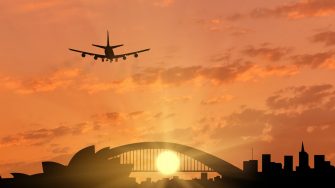Sustainable aviation soaring to new heights
In a world reshaped by the challenges of the COVID-19 pandemic, a unique collaboration has emerged from the turbulence to revive the aviation industry.
In a world reshaped by the challenges of the COVID-19 pandemic, a unique collaboration has emerged from the turbulence to revive the aviation industry.

During the COVID-19 pandemic, Dr Tay Koo from the UNSW Sydney School of Aviation found himself navigating uncharted waters alongside key players in Australia’s tourism sector.
“During COVID, when the borders shut down, traditional avenues for aviation partnerships were halted,” Dr Koo says. This was a pivotal moment, as grounded fleets across the world pushed the industry to innovate.
Australians could not hold or attend the annual international air routes conference ‘Routes World’, where the world’s airports and airlines come together in a speed dating setting.
“This is thousands of people getting together to develop business deals in a highly confidential setting,” Dr Koo says.
“So our Tourism Australia partner, led by aviation manager Trent Banfield, decided to host an air routes conference specifically for Australia within their existing Tourism Exchange forum. It was a trial, but it turned out to be incredibly successful.”
Tourism Australia is the statutory authority of the federal government that markets Australia to the world as a destination for leisure and business events. As part of the Australian Tourism Exchange (ATE), which is the largest event each Tourism Australia hosts each year, Banfield spear-headed a dedicated aviation program. This has since continued and will celebrate its fifth continuous year as part of ATE25.
An idea emerged during conversation to develop a data-informed recovery strategy that identified and re-established sustainable air routes in partnership with experts such as Dr Koo. An anonymous, but well-respected, participant says, “having the presence of experts and practitioners other than airports and airlines means we can have richer conversations.”
To leverage the momentum of the Australian conference, Dr Koo and his team organised an aviation data science competition, inviting UNSW students to engage with real-world data. The judging panel was organised by Banfield, and included industry experts from Qantas, Sydney Airport, Sunshine Coast Airport, Tourism Australia’s sustainability team and Cirium.
“We partnered with aviation data analytics company Cirium, which provided the students with commercially valuable data,” he says. “And the response was fantastic. The winners were showcased at the Australian Tourism Exchange, gaining invaluable exposure.”
The success of the initial competition set the stage for further collaboration.
“In 2022, we held another competition and began to craft a research agenda based on industry needs,” Dr Koo says. “We realised the importance of aligning our research with what stakeholders valued."
"This alignment takes time and effort."
One standout team from the competition continued to work with Dr Koo, Banfield and Cirium, contributing to ongoing projects – building a lasting impact of this initiative on student careers. The team was composed of graduates from the UNSW Schools of Mathematics and Statistics, Business, Computer Science and Engineering, as well as the School of Aviation.
As the collaboration deepened, the team published a research paper in early 2023 – co-authored with Tourism Australia, with data contributed by Cirium. The paper translated their findings into sustainable air route development insights for the aviation sector.
“We communicated our research to various stakeholders – different airports, airlines and government departments – seeking feedback to refine our work,” Dr Koo says. “This iterative process allowed us to continually update our data and metrics."
Balancing competition with collaboration to drive sustainability forward is no easy feat. But the collaboration is proof that it can be achieved by building trust and fostering a community dedicated to a shared vision.
“We aim to identify commonly accepted metrics for sustainability that can assist in driving sustainability goals across the industry,” Dr Koo says. “It is crucial that these metrics are acceptable to a broad range of stakeholders – from small regional airports to major international hubs.”
Throughout the challenges of the COVID pandemic, Tourism Australia promoted a unified approach in international aviation recovery – they called it the ‘Team Australia’ approach.
“We believe that sustainability requires a ‘Team Australia’ approach,” Dr Koo says. “The aviation industry came together during lockdown and promoted collaboration.”
“Airports and airlines must work together to achieve common goals, especially when addressing complex challenges like biofuel scaling.
“There is no single person responsible for sustainability.”
He says the data science competition was translated into a Work Integrated Learning project, counting towards course credits at UNSW. In 2023, 25 UNSW students participated in the team-based activity led by Tourism Australia and powered by Cirium’s data.
One of Dr Koo’s Master’s students works at a major international airport with one of the airport VPs as an external advisor.
“We engage with various industry professionals as part of our supervisory team,” he says. “This collaboration is a powerful tool for shaping future research and policy and was made possible by the aviation program at ATE.”
As the team looks to the future, they intend to apply for a larger linkage grant to expand their impact on sustained viability.
Reflecting on the journey so far, Dr Koo says the ethos of collaboration and shared vision among all stakeholders is what drives him.
“As a result of our expertise, we're the only university that are continuously being invited to this aviation event,” he says. “We're trying to translate our findings into a tool for the industry to support internal decision making.”
“We’ve created a model that can lead to significant advances in sustainable aviation, and we’re committed to seeing it through.”
Impact stories